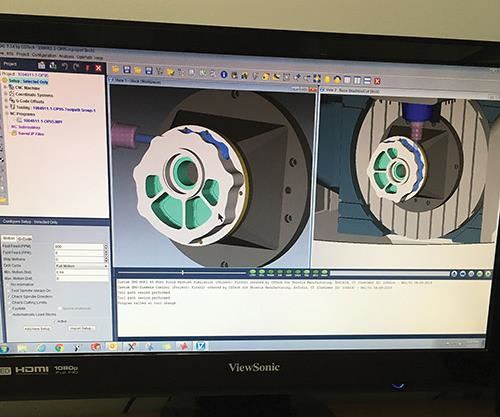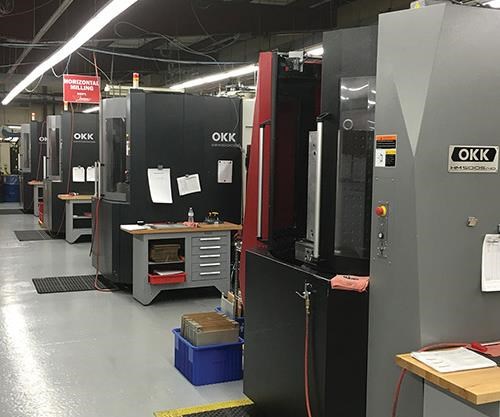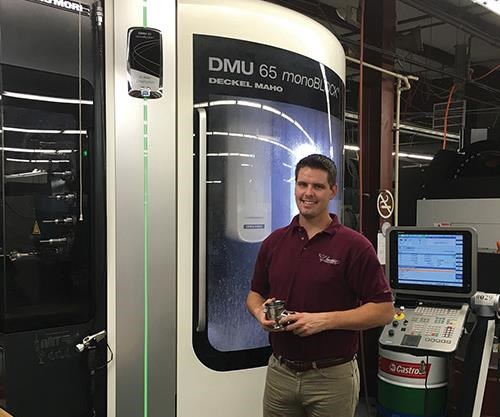Verification, Simulation Reduce CNC Machine Crashes
Increasingly complex parts led to more crashes and longer setup times at Phoenix Manufacturing Inc. Vericut software from CGTech improved product quality and increased shopfloor efficiency.
Share





In order to manufacture increasingly intricate parts, Phoenix Manufacturing Inc. (Enfield, Connecticut) needed to add complex machines to its shop floor. In doing so, however, the company witnessed an increase in CNC machine crashes and long setup times. Vericut NC toolpath verification and simulation software from CGTech (Irvine, California) helped eliminate those crashes while improving product quality and shopfloor efficiency.
Phoenix Manufacturing’s road to becoming a precision component manufacturer began in 1989, when the late Lech Paluch and a business partner bought a company out of bankruptcy. In 2009, Mr. Paluch left the company in the hands of his wife Krystyna and his two children, Peter Paluch and Martha Prou. Today, the 65-employee shop operates dozens of high-tech CNC machine tools in 25,000 square feet of space to produce check-valve housings, nozzle plates, shroud assemblies and other challenging parts from difficult materials such as Inconel, titanium, and stainless steel forgings and castings. Many of these parts are produced on one of the shop’s five-axis machining centers or multispindle turn-mill machines.
In this increasingly high-tech machining environment, collisions are an ever-present possibility. Today’s CNC machines have more axes, spindles, tools and speed than ever before. Parts are more complex as well, and manufacturers are pressured to deliver them in less time and in smaller lot sizes. A growing emphasis is placed on doing things right the first time, with no margin for programming errors or operator mistakes.
In 2011, when he was responsible for the programming area, Quality Engineer Peter Paluch decided he needed better tools to combat these types of mistakes. “The parts would come out of the engineering department, and the operators often didn’t know what they were setting up,” he says. He contacted CGTech, the developer of Vericut, to learn more about the software’s verification and visualization capabilities.
“Our CAD/CAM software isn’t detailed enough to get a good idea of what’s going on in the machine,” he says. By comparison, Vericut simulates the machine tool, the cutting tools, toolholders and the workpiece in real time using the post-processed G code. Workpiece gouging, machine interference, air cutting and other inefficient motions become easy to spot using the software. With the Auto-Diff module, differences between the machined workpiece and its CAD model are clearly identified. “Vericut shows you the whole picture,” he says.
To begin integrating the software into the shop, Mr. Paluch attended Vericut training for just one week. After that, Phoenix Manufacturing relied on the help from CGTech for the modeling of the machine tools, workholding and toolholder assemblies so that the 3D simulations in Vericut would be accurate. “They were very helpful,” he says. “I walked into training not knowing anything about Vericut, and walked out with enough knowledge to start using the software efficiently.”
For the rest of the implementation, Mr. Paluch relied on solid models from his cutting tool and toolholder suppliers that he was able to import directly in STL file format from cloud-based libraries. Since he already had CAD drawings of the various fixtures and other workholding the shop used, Mr. Paluch says it was a simple matter to convert them into one of the many formats recognizable by Vericut.
Phoenix Manufacturing has since sent several additional programmers to the Vericut class, and occasionally participates in the local Vericut User’s Exchange (VUE), where shops can come together to learn new techniques and exchange ideas. Mr. Paluch has even taken a Vericut refresher course to catch up on the latest developments in the software. As it turns out, this was good preparation for the company’s latest advancements in machine tool technology: purchasing its first simultaneous five-axis machine, a DMU 65 monoBlock from DMG MORI. “It was a pretty steep learning curve for us,” Mr. Paluch says. “Prior to the five-axis machine, all of our complex milling work was done on one of our OKK tilt-rotary horizontals. Vericut helped us out big-time with the new machine.”
That learning curve is about to get a lot steeper. Phoenix Manufacturing has also recently purchased more DMG MORI equipment, including a pair of Y-axis-capable NLX 2500 universal twin-spindle lathes.
“We bought the first NLX and liked it so much, we ordered another one a couple months later,” he says. At the time of this writing, the rollout of the new machines in Vericut had been hampered by high sales demand, but Mr. Paluch’s goal was to be operational on the turn-mills with Vericut by the end of this month. He has other plans as well, as Phoenix Manufacturing is making a push for additional engine component work. “We’re looking at tougher materials and tougher machinery,” he says. “That’s where Vericut will really become key for us, as we evolve into more complex machining and the setups become even more complex than they are now.”
Until that time, the manufacturing team will continue to prove out all new programs with Vericut and validate legacy programs when they circle around again. Quite often, this leads to cycle time reductions, Mr. Paluch says. The simulations themselves help with process optimization. Before the job even hits the floor, the person reviewing it has an opportunity to see the tool paths and look for areas that can be improved. Since the process can be completely visualized, it gives team members a better chance to combine operations or machine part features in a more effective manner. It also helps them make better manufacturing decisions,
he says.
“You have to keep evolving with technology in this business or you will get left behind,” he says. “Vericut helps us do that. It gives the guys confidence—we can now review the tool paths and identify any problems before the job hits the shop floor.”
Related Content
Continuous Improvement and New Functionality Are the Name of the Game
Mastercam 2025 incorporates big advancements and small — all based on customer feedback and the company’s commitment to keeping its signature product best in class.
Read More4 Commonly Misapplied CNC Features
Misapplication of these important CNC features will result in wasted time, wasted or duplicated effort and/or wasted material.
Read MoreCutting Part Programming Times Through AI
CAM Assist cuts repetition from part programming — early users say it cuts tribal knowledge and could be a useful tool for training new programmers.
Read More5 Tips for Running a Profitable Aerospace Shop
Aerospace machining is a demanding and competitive sector of manufacturing, but this shop demonstrates five ways to find aerospace success.
Read MoreRead Next
5 Rules of Thumb for Buying CNC Machine Tools
Use these tips to carefully plan your machine tool purchases and to avoid regretting your decision later.
Read MoreRegistration Now Open for the Precision Machining Technology Show (PMTS) 2025
The precision machining industry’s premier event returns to Cleveland, OH, April 1-3.
Read MoreBuilding Out a Foundation for Student Machinists
Autodesk and Haas have teamed up to produce an introductory course for students that covers the basics of CAD, CAM and CNC while providing them with a portfolio part.
Read More






































